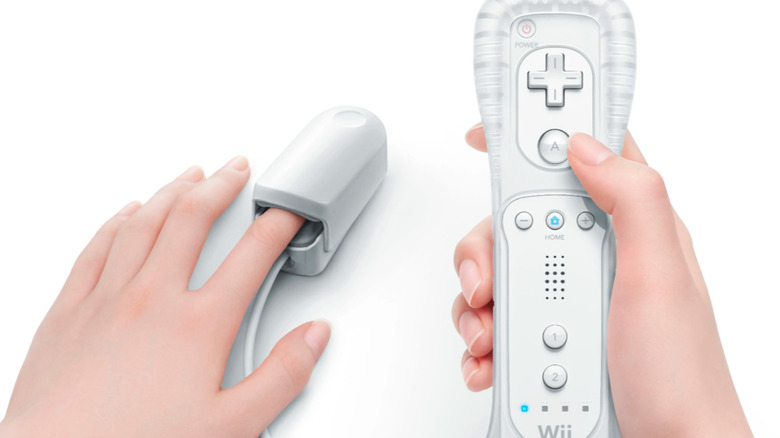Whatever Happened To The Nintendo Wii Vitality Sensor?
When you think of the Nintendo Wii, chances are that you're also thinking about at least one item from the massive pile of white, plastic accessories that were manufactured for the console. Whether it's the Balance Board made for "Wii Fit," the Wii Motion Plus dongle that gave Wii remotes more accurate motion controls, or even the Wii's Wi-Fi USB Connector, it's near-impossible to own the console without having at least one of its many peripherals. However, one supplementary device for the system that truly crossed the line into full-out weird territory was the Wii Vitality Sensor.
Announced by Nintendo in 2009, the product was a pulse monitor that plugged into the Wii remote and would check the user's stress levels, adjust game experiences based on the player's heart rate and help them relax if necessary (via Engadget).
It's no surprise that the announcement of the Vitality Sensor brought a lot of press attention and, admittedly, some confusion back in the day, as the concept seemed pretty futuristic and tech-savvy. But with all the buzz — both positive and negative — that originally surrounded the device, some veteran fans may wonder why they don't have one of these little gadgets collecting dust in a bin full of Wii accessories somewhere in their basement right now. As it turns out, the story of the Vitality Sensor marks one of the rare occasions when Nintendo couldn't quite see its innovative vision through to the end.
The Vitality Sensor got shelved
Following Nintendo's grand reveal of the Wii Vitality Sensor in 2009, things got quiet — a little too quiet. Years passed without any update on the accessory until 2011, when the late Nintendo president Satoru Iwata addressed the long wait time. The executive said the delay was a result of the company trying to make the product function with 99 percent of consumers, regardless of their biological differences (via Engadget). Two more years passed, with Nintendo moving from the Wii to its unfortunate flop of a successor console, the Wii U, and little news was given on the Vitality Sensor in this time, too.
Finally, at a shareholders event in 2013, Iwata confirmed that the Vitality Sensor project had been canceled, noting its 90 percent effectiveness rate during trial runs was not up to the company's standards. "The Wii Vitality Sensor is an interesting device, and we did various experiments to see what is possible when it was combined with a video game," he said. "But, as a result, we have not been able to launch it as a commercial product because we could not get it to work as we expected and it was of narrower application than we had originally thought."
However, while the Wii Vitality Sensor never did end up seeing the light of the day, it's actually only one part of a much greater story regarding Nintendo's relationship with health-based hardware.
Nintendo's quality of life initiative keeps the dream alive
Something wholly unique to the Wii at the time was its image as not just a gaming console, but a device for facilitating an active and healthy lifestyle. This idea was pioneered early on by the success of titles like "Wii Sports" and "Wii Fit," and Nintendo even went so far as to obtain the endorsement of the American Heart Association on the Wii's box in 2010. But while its next leap into this market — the Vitality Sensor — never released, it did herald a new business strategy for the company.
In 2014, roughly a year after the Vitality Sensor was pronounced dead, Satoru Iwata announced that Nintendo would undergo a 10-year plan known as the "quality of life initiative," during which they would focus on developing health-related products that could improve the lives of the users. It wasn't long before Nintendo had a new poster child project for the initiative: a non-contact sleep monitor that could monitor body signals while sleeping and visualize the information. Unfortunately, this device met a similar fate to the Vitality Sensor, getting canned in 2016 (via Games Industry.biz). However, Nintendo did file a new patent for a health-monitoring device with smartphone functionality in 2019 (per Video Games Chronicle), correlating with comments from current Nintendo president Shuntaro Furukawa that same year that Nintendo has not abandoned its hopes of developing more quality of life projects.
Who knows? Perhaps the Vitality Sensor could be reborn some day.



